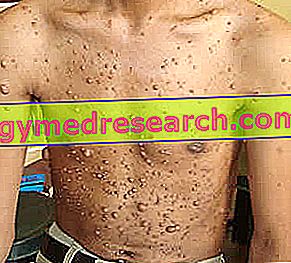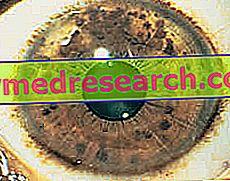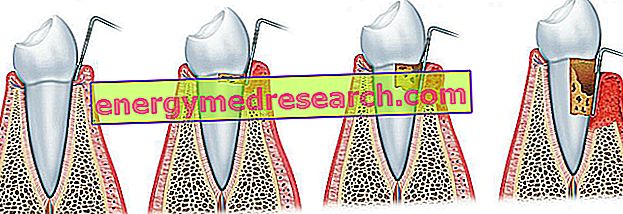Generality
Neurofibromatosis is a genetic disease, often transmitted in a hereditary way, which causes the onset of several tumors at the level of the nervous system.
These neoplasms are mostly benign, although they can sometimes evolve and become malignant.
The symptoms and signs are very numerous and depend on the type of neurofibromatosis in place: in fact, there are three different forms of the disease, each caused by a specific genetic mutation.

Figure: Type 1 neurofibromatosis: patient with a fair number of neurofibromas. Unfortunately, there are sick people in far worse conditions. From the site: //gudhealth.com
The diagnosis of neurofibromatosis is based on an accurate physical examination and instrumental tests.
The therapy, while not curing the disorder, is very important, because it limits the symptoms and prevents the most serious complications.
Short reference to some key concepts
Before describing neurofibromatosis, it is useful to make a brief reference to some key concepts.
What is DNA? It is the genetic heritage in which the physical features, predispositions, physical qualities, character, etc. are written. of a living organism. It is contained in all the cells of the body having a nucleus, as it is inside this one.
What are chromosomes? According to the definition, chromosomes are the structural units in which DNA is organized. The human cells contain, in their nucleus, 23 pairs of homologous chromosomes (therefore, 46 chromosomes in all); each pair is different from another, as it has a specific gene sequence.
What are genes? They are short stretches, or sequences, of DNA with a fundamental biological meaning: from them, in fact, proteins are derived, that is, fundamental biological molecules for life. In genes, there is "written" part of what we are and what we will become.
What is a genetic mutation? It is a mistake within the DNA sequence that forms a gene. Because of this error, the resulting protein is defective or completely absent. In both cases, the effects can be deleterious both for the life of the cell, in which the mutation occurs, and for that of the organism in its totality.
Congenital diseases and neoplasms (or tumors) are responsible for one or more genetic mutations.
What is neurofibromatosis?
Neurofibromatosis is an inherited genetic disorder that alters the normal growth and development processes of nervous system cells. As a result of these abnormalities, various tumors of the encephalon, spinal cord and nerves (both cranial and peripheral) arise.
Neoplasms are almost always benign, but it is possible that they may evolve and become malignant.
Difference between a benign tumor and a malignant tumor?
In general, a tumor is considered benign when the rate of growth of the tumor cell mass is slow. Conversely, a tumor is considered malignant when the rate of growth of the tumor mass is high.
DIFFERENT TYPES OF NEUROPHIBROMATOSIS AND EPIDEMIOLOGY
There are three different types of neurofibromatosis: type 1 neurofibromatosis (NF1), type 2 neurofibromatosis (NF2) and Schwannomatosis.
- Type 1 neurofibromatosis ( NF1 ): is the most common form of neurofibromatosis, with one case every 3, 000 individuals.
- Type 2 neurofibromatosis ( NF2 ): it is less common than type 1, with about one case per 35, 000 people.
- Schwannomatosis : recently discovered, it is by far the rarest form, with about one case per 40, 000 people. It can be considered a variant of neurofibromatosis type 2; in this text, given the differences between Schwannomatosis and NF2, the former will be treated as a stand-alone neurofibromatosis.
Although they are all considered equally belonging to the neurofibromatosis group, the three forms have notably different causes and symptoms.
Causes
Neurofibromatosis is caused by a genetic mutation, which can be transmitted by the parents or arise, in a completely spontaneous way, during the development of the embryo (ie after the sperm has fertilized the egg). For this reason, neurofibromatosis is considered a genetic disease, sometimes inherited .
Each of the three different forms of neurofibromatosis is characterized by a specific genetic mutation, which explains why the three diseases do not present the same symptoms.
TYPE 1 NEUROPHIBROMATOSIS
The gene that, once mutated, determines type 1 neurofibromatosis is located on chromosome 17 and is called NF1. The normal function of NF1 is to produce the neurofibromy, a very abundant protein in the nervous system and responsible for regulating cell growth.
The mutation deprives the neurofibromine nerve cells and alters their normal development: all this results in the appearance of neoplasms.
TYPE 2 NEUROPHYBROMATOSIS
The gene responsible for type 2 neurofibromatosis resides on chromosome 22 and is called NF2. It produces a protein, called merlina (or Schwannomina ), which regulates the growth of nerve cells under normal conditions.
The lack of healthy merlin production causes uncontrolled cellular development and this increases the possibility of developing tumors.
SCHANNOMATOSI
Schannomatosis is associated with a mutation in the SMARCB1 gene, located on chromosome 22 . However, other genetic alterations also appear to exist. Studies are still ongoing in this regard.
TRANSMISSION AND HEREDITARY
About half of those affected by type 1 and type 2 neurofibromatosis have a parent with the same disease, which means that the family component (ie heredity) is very important.
Furthermore, NF1 and NF2 fall within the so-called autosomal dominant diseases : this means that, on a hereditary level, a child of a sick parent has 50% of the chances of getting sick in turn.
All the remaining unfamiliar cases of NF1 and NF2 are due to spontaneous mutations, which occur unexpectedly during embryonic development.
Finally, as regards Schwannomatosis, it is not yet sufficiently clear how much and how the family component affects it.
Symptoms and Complications
To learn more: Neurofibromatosis symptoms
Each form of neurofibromatosis is distinguished by markedly different symptoms and signs. Of the three, type 1 neurofibromatosis is certainly the one with the widest and most complicated symptomatology; in fact, it manifests itself in numerous parts of the body with tumors (mostly benign), learning deficits, physical defects, cardiovascular disorders, etc.
Neurofibromatosis type 2 and Schwannomatosis are characterized, instead, by a narrower but equally dramatic symptom spectrum; the main manifestations consist mainly of benign tumors, of the Schwannoma type.
What are Schwannomi?
Schwannomas are benign tumors that originate from the Schwann cells of the peripheral nervous system. Schwann cells belong to the so-called glia cells, which provide stability and support for the many nerves present in the human body.
TYPE 1 NEUROPHIBROMATOSIS
Already present in the first years of life, the typical symptoms and signs of type 1 neurofibromatosis are:
- Skin anomalies . They are by far the most characteristic signs of NF1. These are mainly coffee-milk colored spots, which are present from birth (with rare exceptions, in which they appear around the third year of life). The dimensions are around 5 mm wide and any large number (compared to a smaller number) does not mean that the disease is more serious.
In addition to the coffee-milk-colored spots, around 4-5 years old freckles appear in the axillae and groin, whereas in adulthood there are protuberances above and below the skin, neurofibromas . Neurofibromas are benign tumors, of variable size, which - until they involve the nerves ( plexiform neurofibromas ) - do not create particular disorders, if not discomfort from the aesthetic point of view.

- Physical-skeletal defects . These are scoliosis, arched legs, short stature and head larger than normal . The first three are certainly caused by abnormal bone growth and low bone mineral density. The last, the large head, does not have a clear etiology.
- Learning deficits . It is quite common (60% of cases) for patients to suffer from mild cognitive disorders (above all, learning difficulties). Among children, it is easy to observe the so-called attention deficit hyperactivity disorder .
- Neurological problems . They consist of attacks of epilepsy (7% of cases), hydrocephalus and benign brain tumors. The latter cause sudden personality changes and momentary loss of balance and coordination.
- Hypertension . It occurs in 20% of cases and appears to be due to benign tumors, which affect the kidneys making them inefficient. High blood pressure increases the chance of developing stroke or heart attacks .
The possible complications, which arise more or less frequently, are:
- Osteoporosis . Abnormal bone growth and reduced bone mineral density, in the long run, predispose to developing this disorder. Leg fractures are quite frequent.
- Increased number and evolution of neurofibromas . These tumors tend to increase in number coinciding with puberty, pregnancy and menopause. Moreover, when the patient is around 20-30 years old, they can evolve and grow, becoming real malignant nerve tumors.
- Anxiety and depression . They arise in adulthood, due to aesthetic defects (defects, which, in some cases, tend to be accentuated).
TYPE 2 NEUROPHYBROMATOSIS
The characteristic symptoms and signs of type 2 neurofibromatosis appear towards the end of adolescence and consist of:
- Gradual loss of hearing and lack of balance . They arise due to a benign brain tumor known as acoustic neuroma (or vestibular Schwannoma ). This neoplasm affects the eighth cranial nerve, the vestibulocochlear, which controls balance and auditory abilities. Other classic manifestations are tinnitus and vertigo. The acoustic neuroma is, by far, the most common sign among NF2 patients.
- Skin plates . They are benign tumors of the skin, about 2 cm wide and dark in color. They occur in about half of patients.
- Meningiomas . They are brain tumors ( meninges ), in this case benign, which occur in about half of the patients. Usually they do not cause symptoms, but when they do they determine: headache, vomiting, epilepsy, double vision, personality changes, vision problems, speech difficulties, lack of memory, etc. (the symptomatology depends on the brain area affected by the neoplasm).
- Ependymomas . They are benign tumors of the spinal cord, which affect about half of NF2 sufferers. They can cause lower back pain and muscle weakness.
The possible complications, which arise more or less frequently, are:
- Total deafness . It is due to the worsening of the acoustic neuroma.
- Facial paralysis . The worsening of the acoustic neuroma also affects the VII cranial nerve, the facial, which is located very close to the VIII. This results in loss of control of the muscles of the face.
- Vision problems . They are due to benign retinal tumors, which cause cataract episodes in old age.
- Peripheral neuropathy . It is caused by damage to the peripheral nervous system. The origin is probably due to benign peripheral nerve tumors. Characteristic signs are widespread pain and tingling in the limbs and muscle weakness.
schwannomatosis
The symptoms of Schwannomatosis appear between the ages of 20 and 30. The main disorders (chronic pain spread over the whole body and muscle weakness) derive from tumors (the so-called Schwannomas), mostly benign, which affect some cranial nerves, the spinal nerves and the peripheral ones.
Among the target cranial nerves, there is no VIII, which distinguishes Schwannomatosis from NF2.
In the same way as NF2, on the other hand, there are no cognitive deficits among patients with Schwannomatosis.
WHEN TO REFER TO THE DOCTOR?
It is good to consult your doctor when you notice the characteristic signs, described above, of each form of neurofibromatosis. This means, for the NF1, the presence of coffee-milk-colored spots; for NF2, hearing loss and balance; for Schwannomatosis, widespread chronic pain and muscle weakness.
Diagnosis
The diagnosis of any form of neurofibromatosis begins with the objective examination, in which the doctor analyzes the presence of the most characteristic signs and investigates the family history of the patient.
After that, the patient undergoes more specific checks, aimed at assessing: sight and eye, hearing (if NF2 is suspected), the position of benign tumors scattered around the body and, finally, DNA.
EXAMINATION OBJECTIVE AND FAMILY HISTORY
In addition to the evaluation of characteristic signs, it is very important for the doctor to also know the family history of a patient. If the latter, in fact, has or had a parent with neurofibromatosis, the diagnosis is already well established, since the probability of a hereditary transmission of the disease is high.
SPECIFIC TESTS OF THE EYE AND HEARING
Eye exams are essential for recognizing Lisch nodules and cataracts, two unequivocal signs of NF1 and NF2, respectively. For these controls, the patient should contact an ophthalmologist, as these signs cannot be found on physical examination.
Audiometric tests, on the other hand, are essential for the exclusive diagnosis of NF2, as, as we have seen, acoustic neuroma causes hearing loss. There are several targeted tests, which serve to sanction which sounds are still perceived and which are not.
RADIOLOGICAL TESTS
Radiological examinations, to which the patient suspected of neurofibromatosis is subjected, are computerized axial tomography ( CT ) and nuclear magnetic resonance ( NMR ). These investigations provide clear images of the location and extent of various benign tumors that affect the brain, eyes, spinal cord, peripheral nerves etc.
In some cases, the signs of neurofibromatosis are so obvious that neither CT nor MRI would be needed, however these tests are equally useful, because they show whether and how neoplasms develop. This is useful when you are undergoing treatment.
DNA ANALYSIS
There are several genetic tests, which, by analyzing the DNA, identify the mutations responsible for the various neurofibromatosis. These are reliable tests, which can be performed even in prenatal age, if the suspicion of neurofibromatosis is concrete (for example, when a parent is affected by the disease).
Treatment
Unfortunately, there is no cure for curing neurofibromatosis permanently. The only therapeutic countermeasures that can be put into practice are to reduce the symptoms and prevent the most serious complications. For the best results, it is essential to periodically monitor the health status of the patient, especially during the adolescent years, when benign tumors are likely to undergo evolutions and changes.
Timeliness? OF PERIODIC TREATMENT AND MONITORING
Starting treatments promptly (therefore as soon as possible) reduces the likelihood of unpleasant consequences. For example, keeping hypertension (one of the symptoms of NF1) under control right away can prevent the onset of dramatic circumstances, such as stroke and heart attack.
With periodic monitoring of the situation, the prevention of complications is more effective. In fact, only in this way the doctor is able to recognize possible evolutions of the disease: from the formation of new benign tumors (gliomas of the optical pathways, neurofibromas, etc.) to the aggravation of existing ones (plexiform neurofibromas), from the worsening of the anomalies physical-skeletal to the aggravation of cognitive and neurological disorders.
The most critical phase, which deserves to be kept constantly under control, is that of early youth and adolescence, as it is in this period that changes in health conditions are more frequent.
SURGERY
Surgery is used to remove all those tumors that compromise the nerves and, in general, the conduction of the nervous signal. Removal can be total or partial, depending on the location and degree of infiltration of the neoplasm. A tumor, which from benign becomes malignant, must be operated urgently.
A classic surgical procedure is that intended for the removal of acoustic neuroma, in patients with NF2. The benefits must be evaluated before operating, because the operation could also damage the cranial facial nerve (which, as mentioned above, is in the immediate vicinity of the VIIIth cranial nerve).
RADIOSURGERY
Radiosurgery represents a solution to the cure of tumors that are difficult to reach by the surgeon. It uses a sophisticated instrumentation, through which a concentration of radiation is directed directly against the mass of tumor cells. In this way, in addition to directly affecting the neoplasm, the side effects due to radioactive exposure are also limited.
Radiosurgery is particularly indicated against Schwannomas and acoustic neuromas.

Figure: acoustic neuroma or vestibular Schwannoma. It can be seen that the tumor grows at the level of the vestibulocochlear cranial nerve, but also in the vicinity of the facial one. From the site: //baptisthealth.net/
Prognosis
Being an incurable and difficult to control disease, neurofibromatosis (whatever form it may be) never has a positive prognosis.
The quality of life of the patient, even when the therapies are implemented early, is greatly affected.
The support of the family is very important, especially in the adolescent phase of the patient: the closeness of the family members, in fact, limits the dramatic effects of the complications and supports in moments of depression, typical above all of type 1 neurofibromatosis.




